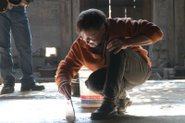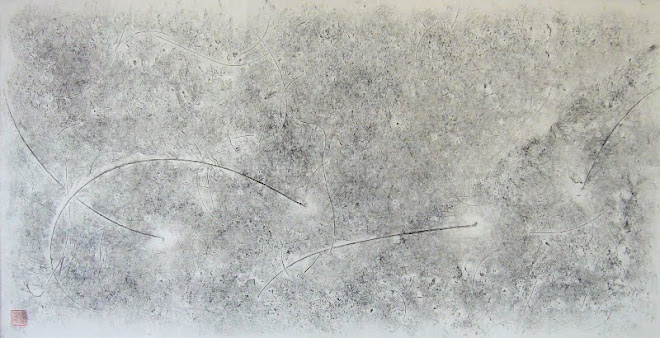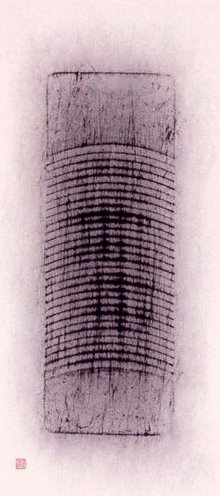During my first stay as artist in residence in Fuzhou, autumn 2005, my Chinese friends drew my attention to a house called "German Garden". I was surprised by the European style of the architecture and was told about a district from the 19th Century in which foreigners lived and worked. The infrastructure of business premises, administration buildings, embassies, schools, churches, hospitals and suburban gardens testified to the social structure of their inhabitants and the importance to the city. Visiting the quarter, we only found a few houses and fragments of the former development still existing. The transformation of large areas of Chinese cities into tower blocks causes an immense loss of knowledge of architecture and traditions. Sites, which provide experience of perceptible history, are wiped out as if they never existed. Questions about the historical identity of our society will be soon answered only by selected sources intended for this purpose, such as maps, photos, books and museum exhibitions. My scroll entitled "German Garden" is an attempt to use the method of documenting to transform "archaeology of the presence" into a work of art. The practice of ink-rubbing taken from stone calligraphy has an old tradition in China. These days raising awareness matters -- for the sake of history itself and its material culture. History is a living process of remembrance, which shapes the traces of human thinking, emotion and acting that are perceptible as a contribution to our self-positioning in the world.
skip to main |
skip to sidebar

December 2005, Fuzhou, China
.jpg)
Ink Rubbing, Chinese Ink on Paper, 70 x 35 cm, March 2002, Tainan, Taiwan

Ink Rubbing, Chinese Ink on Paper, 37 x 83 cm on Scroll, March 2000, Taipei Taiwan
墨品
MO WORKS
Works with ink and pigment on paper
THOMAS JACOBI

December 2005, Fuzhou, China
Biography
1959 Born in Aachen, Germany
1981-1990 Academy for Applied Arts, Vienna, Austria
MA in Painting and Printmaking
1992-1999 lives and works in Taipei, Taiwan
Since 2000 lives and works in Bad Ems, Germany
Since 2005 regular stays in China
Since 2010 lives and works in Glasgow, Scotland
Contact e-mail:
thomasems03@yahoo.co.uk
1981-1990 Academy for Applied Arts, Vienna, Austria
MA in Painting and Printmaking
1992-1999 lives and works in Taipei, Taiwan
Since 2000 lives and works in Bad Ems, Germany
Since 2005 regular stays in China
Since 2010 lives and works in Glasgow, Scotland
Contact e-mail:
thomasems03@yahoo.co.uk
RELATED WEB SITES
NEWS
- 'Cleansing the House with Ink' 以墨洗宅, Ricefield Arts and Cultural Centre, Glasgow, UK
- Wellcome Collection, London, UK
- Künstlerhaus Schloß Balmoral, Bad Ems, Germany
- 'Cleansing the House with Ink' 以墨洗宅, Ricefield Arts and Cultural Centre, Glasgow, UK
- Working at CAA Hangzhou, China
- Amateur Architecture Studio, CAA Hangzhou, Xiangshan Campus
- University of Glasgow
- "Cleansing the House with Ink"
SELECTED EXHIBITIONS
- 2012 "7000 Imprints 印記 7000 Abdrucke", Wandelhalle Bad Wildungen, Germany
- 2010 "Culture of Capital" Liverpool Biennial 2010, Liverpool, UK
- 2010 "SANCTUARY", St George's German Lutheran Church, London, UK
- 2010 "Cleansing the House with Ink" 以墨洗宅, Ricefield Arts and Cultural Centre, Glasgow, Scotland, UK
- 2009 "the shadow of the hand writes before the thought" / "Cleansing the House with Ink", CLIMATE FOR CHANGE, Fact, Liverpool, UK
- 2009 "From A Distance - At Close Range II", Ricefield Arts and Cultural Centre, Glasgow, Scotland, UK
- 2008 "Local Heroes", View Two Gallery, Liverpool, UK
- 2008 "From A Distance - At Close Range", View Two Gallery, Liverpool Biennial 2008, Liverpool, UK
- 2007 "100=1" Exhibition, Fuzhou, China
- 2007 "Art and Environment", International Art Symposium and Exhibition, Xiamen Fine Arts Museum, Xiamen, China
- 2007 "German Garden", Cenentary Celebration Exhibition, Tongji University, Shanghai, China
- 2005 "Welcome to China!", Exhibition and Performance, Rosary Gallery, Fuzhou, China
- 2005 "Hidden Treasures at Public Places", LCB Depot, Leicester, UK
- 2005 "...may contain traces of...", Leonardo Art Center, Uppingham, UK
- 2004 "Textures", Recent Paintings and Prints, The City Art Gallery, Leicester, UK
- 2003 "New Abstract Oil Paintings", Wiener Festwochen, Vienna, Austria
- 2003 "Interior", G. Gelbert Showroom, Cologne, Germany
- 1999 "The Sublime - Attempts of Location Finding", Taipei Fine Arts Museum, Taiwan
- 1998 and 2002 Solo Exhibitions, German Cultural Center, Taipei, Taiwan
- 1998 "Paintings in Broken Taiwanese", Pacific Cultural Foundation Art Center, Taipei, Taiwan
- 1990 Master Degree Show, MAK, Museum for Applied Art, Vienna, Austria
TALKS AND INVITED LECTURES
- 2013 "Form and Function: A Square Huanghuali Table", The Burrell Collection, Glasgow, UK
- 2012 "Think globally - Work locally", Deutsche Kulturwoche, Shanghai Jiao Tong University, Shanghai, China
- 2012 "Die Sprache der Textur", Wandelhalle Bad Wildungen, Germany
- 2011 "The Creative Act - From Material to Meaning", Nankai University, Tianjin, China
- 2011 "Unrolling Chinese Scrolls", Confucius Institute/Hunterian Museum/University of Glasgow, Glasgow, UK
- 2010 "Four Seasons' Drinks in China", The Burrell Collection, Glasgow, UK
- 2009 Visiting Lecturer and Artist in Residence, CAA, Hangzhou, China
- 2009 " 'Mo' Work to Do. Recent Ink Rubbings and Pigment Works on Paper", Huntarian Art Gallery, Glasgow, UK
- 2008 "From A Distance - At Close Range", Working in China 2005 - 2008, China Talks Symposium, View Two Gallery, Liverpool, UK
- 2008 "Serving the West with 'Yeast': New Treasures from the Art Workshop China", International Conference on Cultural Policy Research, Istanbul, Turkey
- 2008 "View Two - Paintings on Chinese Porcelain and Chinese Porcelain on Paintings", National Museums Liverpool, UK
- 2007 "In Search of a New Sincerity", The Real Thing - Contemporary Art from China, Liverpool Tate, Liverpool, UK
- 2006 "Contemporary Art Market and Creative Clusters at M50, Shanghai", Kings College London, UK
- 2006 "Take a Seat and Have a Cup of Art at M50, Shanghai", International Conference on Cultural Policy Research, Vienna, Austria
- 2006 "Cleansing the House with Ink", Artist Talk, Künstlerhaus Schloss Balmoral Art Foundation, Bad Ems, Germany
- 2006 "Welcome to China", Talk and Workshop, Leonardo Art Center, Uppingham School, Uppingham, UK
- 2005 Invited Lectures, Department of Fine Arts, Wu Yi Shan College, Wu Yi Shan City, China
- 2005 "The Artist's Voice between Creation and Interpretation - Intentionality and Distance", Tate Liverpool Research Forum, Liverpool, UK
- 2001 Invited Lectures, Department of Fine Arts, Teachers College, Taipei, Taiwan
REVIEWS
2009 “Metals and stones have voices”
On Thomas Jacobi’s Chinese Works of Art (Chinese)
Author: Prof. Wang Jie (王杰教授), Nanjing University, Nanjing, China
On Thomas Jacobi’s Chinese Works of Art (Chinese)
Author: Prof. Wang Jie (王杰教授), Nanjing University, Nanjing, China
Pavement
.jpg)
Ink Rubbing, Chinese Ink on Paper, 70 x 35 cm, March 2002, Tainan, Taiwan
LANDSCAPE

Ink Rubbing, Chinese Ink on Paper, 37 x 83 cm on Scroll, March 2000, Taipei Taiwan
clc.worldculture design
Copyright © 2009 by Thomas Jacobi
All Rights reserved
All Rights reserved